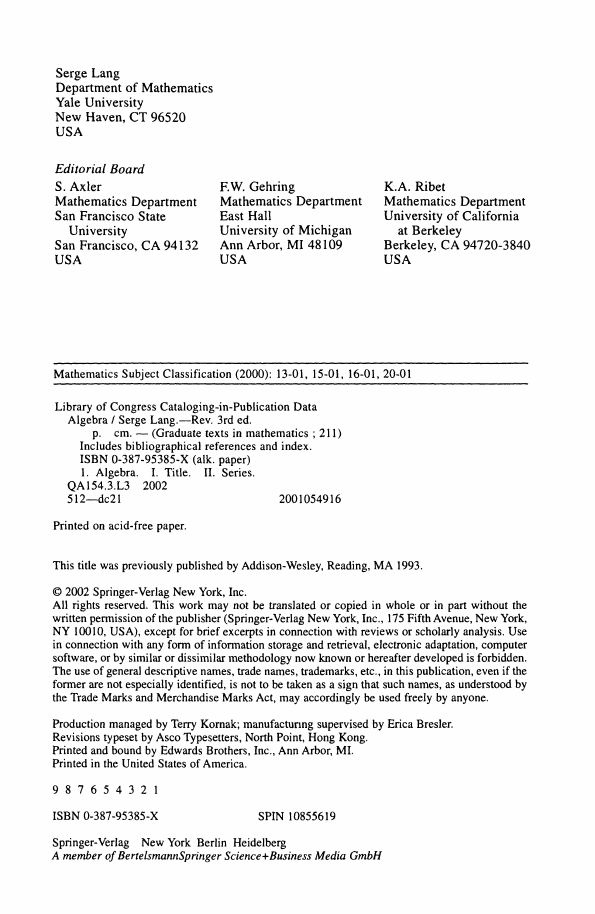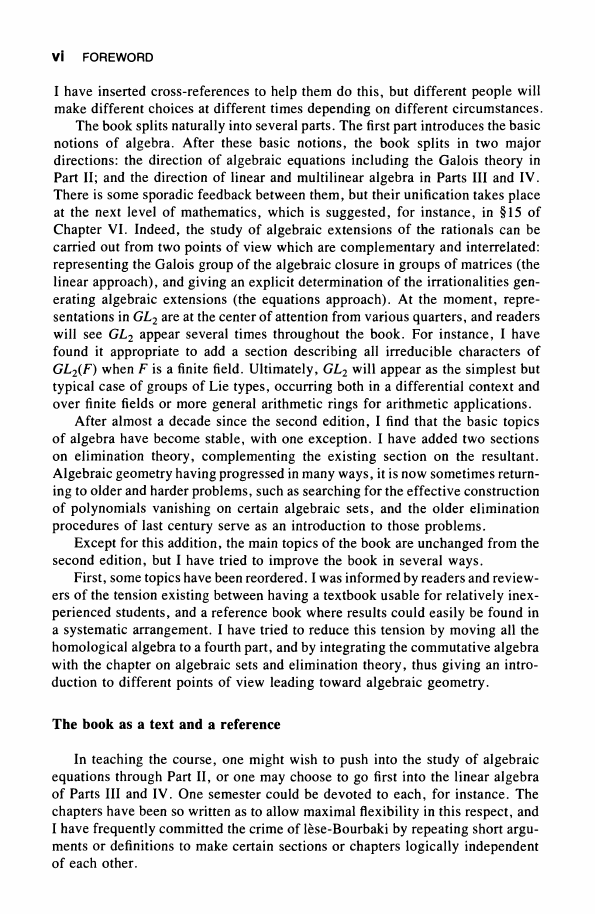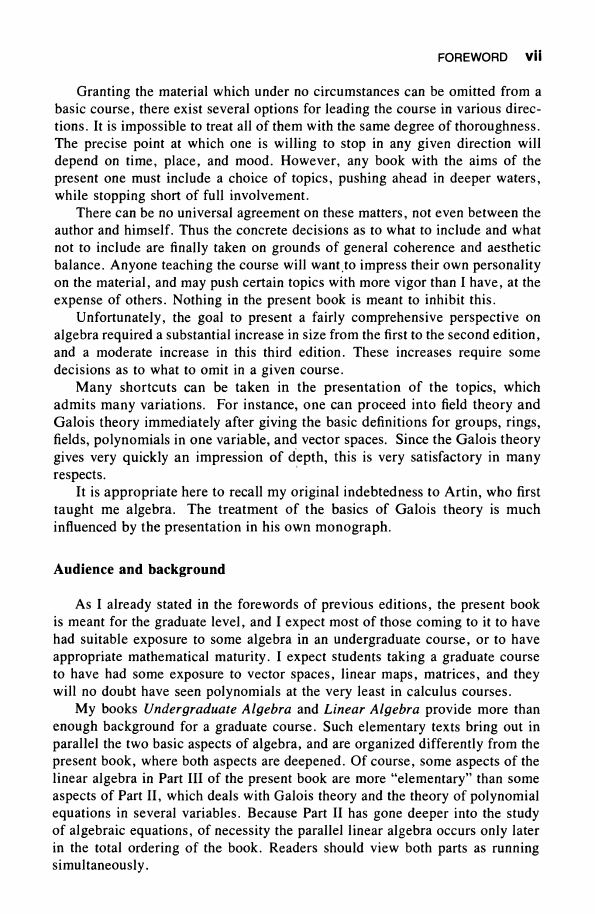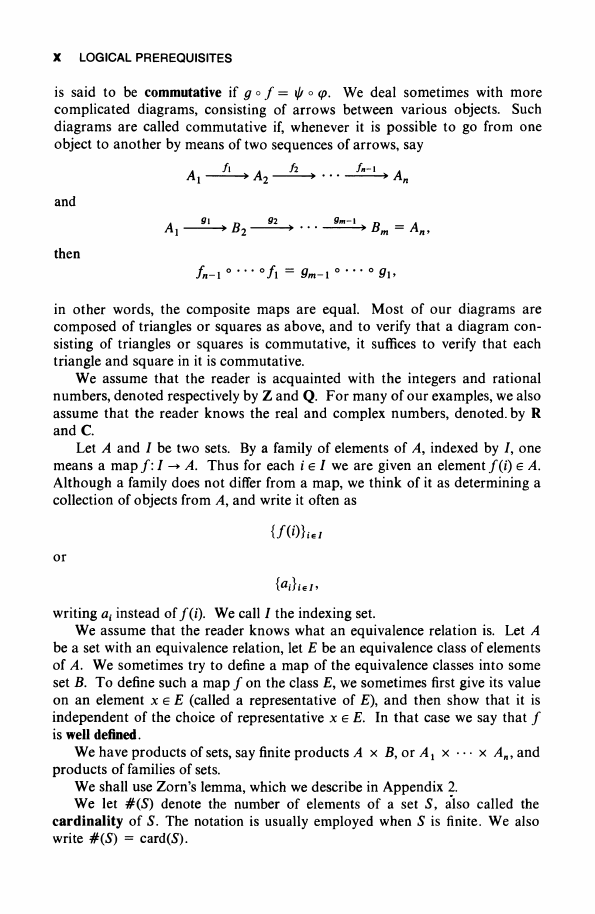Cover
FOREWORD
Logical Prerequisites
CONTENTS
Part One THE BASIC OBJECTS OF ALGEBRA
CHAPTER1 Groups
1. MONOIDS
2. GROUPS
3. NORMAL SUBGROUPS
4. CYCLIC GROUPS
5. OPERATIONS OF A GROUP ON A SET
6. SYLOW SUBGROUPS
7. DIRECT SUMS AND FREE ABELIAN GROUPS
8. FINITELY GENERATED ABELIAN GROUPS
9. THE DUAL GROUP
10. INVERSE LIMIT AND COMPLETION
11. CATEGORIES AND FUNCTORS
12. FREE GROUPS
EXERCISES
CHAPTER2 Rings
1. RINGS AND HOMOMORPHISMS
2. COMMUTATIVE RINGS
3. POLYNOMIALS AND GROUP RINGS
4. LOCALIZATION
5. PRINCIPAL AND FACTORIAL RINGS
EXERC1SES
CHAPTER3 Modules
1. BASIC DEFINITIONS
2. THE GROUP OF HOMOMORPHISMS
3. DIRECT PRODUCTS AND SUMS OF MODULES
4. FREE MODULES
5. VECTOR SPACES
6. THE DUAL SPACE AND DUAL MODULE
7. MODULES OVER PRINCIPAL RINGS
8. EULER-POINCARE MAPS
9. THE SNAKE LEMMA
10. DIRECT AND INVERSE LIMITS
EXERCISES
CHAPTER4 Polynomials
1. BASIC PROPERTIES FOR POLYNOMIALS IN ONE VARIABLE
2. POLYNOMIALS OVER A FACTORIAL RING
3. CRITERIA FOR IRREDUCIBILITY
4. HILBERT'S THEOREM
5. PARTIAL FRACTIONS
6. SYMMETRIC POLYNOMIALS
7. MASON-STOTHERS THEOREM AND THE abc CONJECTURE
8. THE RESULTANT
9. POWER SERIES
EXERCISES
Part Two ALGEBRAIC EQUATIONS
CHAPTER5 Algebraic Extensions
1. FINITE AND ALGEBRAIC EXTENSIONS
2. ALGEBRAIC CLOSURE
3. SPLITTING FIELDS AND NORMAL EXTENSIONS
4. SEPARABLE EXTENSIONS
5. FINITE FIELDS
6. INSEPARABLE EXTENSIONS
EXERCISES
CHAPTER6 Galois Theory
1. GALOIS EXTENSIONS
2. EXAMPLES AND APPLICATIONS
3. ROOTS OF UNITY
4. LINEAR INDEPENDENCE OF CHARACTERS
5. THE NORM AND TRACE
6. CYCLIC EXTENSIONS
7. SOLVABLE AND RADICAL EXTENSIONS
8. ABELIAN KUMMER THEORY
9. THE EQUATION X^n-a=0
10. GALOIS COHOMOLOGY
11. NON-ABELIAN KUMMER EXTENSIONS
12. ALGEBRAIC INDEPENDENCE OF HOMOMORPHISMS
13. THE NORMAL BASIS THEOREM
14. INFINITE GALOIS EXTENSIONS
15. THE MODULAR CONNECTION
EXERCISES
CHAPTER7 Extensions of Rings
1. INTEGRAL RING EXTENSIONS
2. INTEGRAL GALOIS EXTENSIONS
3. EXTENSION OF HOMOMORPHISMS
EXERCISES
CHAPTER8 Transcendental Extensions
1. TRANSCENDENCE BASES
2. NOETHER NORMALIZATION THEOREM
3. LINEARLY DISJOINT EXTENSIONS
4. SEPARABLE AND REGULAR EXTENSIONS
5. DERIVATIONS
EXERCISES
CHAPTER9 Algebraic Spaces
1. HILBERT'S NULLSTELLENSATZ
2. ALGEBRAIC SETS,SPACES AND VARIETIES
3. PROJECTIONS AND ELIMINATION
4. RESULTANT SYSTEMS
5. SPEC OF A RING
EXERCISES
CHAPTER10 Noetherian Rings and Modules
1. BASIC CRITERIA
2. ASSOCIATED PRIMES
3. PRIMARY DECOMPOSITION
4. NAKAYAMA'S LEMMA
5. FILTERED AND GRADED MODULES
6. THE HILBERT POLYNOMIAL
7. INDECOMPOSABLE MODULES
EXERCISES
CHAPTER11 Real Fields
1. ORDERED FIELDS
2. REAL FIELDS
3. REAL ZEROS AND HOMOMORPHISMS
EXERCISES
CHAPTER12 Absolute Values
1. DEFINITIONS, DEPENDENCE,AND INDEPENDENCE
2. COMPLETIONS
3. FINITE EXTENSIONS
4. VALUATIONS
5. COMPLETIONS AND VALUATIONS
6. DISCRETE VALUATIONS
7. ZEROS OF POLYNOMIALS IN COMPLETE FIELDS
EXERCISES
Part Three LINEAR ALGEBRA and REPRESENTATIONS
CHAPTER13 Matrices and Linear Maps
1. MATRICES
2. THE RANK OF A MATRIX
3. MATRICES AND LINEAR MAPS
4. DETERMINANTS
5. DUALITY
6. MATRICES AND BILINEAR FORMS
7. SESQUILINEAR DUALITY
8. THE SIMPLICITY OF SL2(F)/+-1
9. THE GROUPS Ln(F),n>=3.
EXERCISES
CHAPTER14 Representation of One Endomorphism
1. REPRESENTATIONS
2. DECOMPOSITION OVER ONE ENDOMORPHISM
3. THE CHARACTERISTIC POLYNOMIAL
EXERCISES
CHAPTER15 Structure of Bilinear Forms
1. PRELIMINARIES,ORTHOGONAL SUMS
2. QUADRATIC MAPS
3. SYMMETRIC FORMS, ORTHOGONAL BASES
4. SYMMETRICFORMS OVER ORDERED FIELDS
5. HERMITIAN FORMS
6. THE SPECTRAL THEOREM(HERMITIAN CASE)
7. THE SPECTRAL THEOREM(SYMMETRIC CASE)
8. ALTERNATING FORMS
9. THE PFAFFIAN
10. WITT'S THEOREM
EXERCISES
CHAPTER16 The Tensor Product
1. TENSOR PRODUCT
2. BASIC PROPERTIES
3. FLAT MODULES
4. EXTENSION OF THE BASE
5. SOME FUNCTORIAL ISOMORPHISMS
6. TENSOR PRODUCT OF ALGEBRAS
7. THE TENSOR ALGEBRA OF A MODULE
8. SYMMETRIC PRODUCTS
EXERCISES
CHAPTER17 Semisimplicity
1. MATRICES AND LINEAR MAPSOVERNON-COMMUTATIVE RINGS
2. CONDITIONS DEFINING SEMISIMPLICITY
3. THE DENSITY THEOREM
4. SEMISIMPLE RINGS
5. SIMPLE RINGS
6. THE JACOBSON RADICAL,BASE CHANGE,AND TENSOR PRODUCTS
7. BALANCED MODULES
EXERCISES
CHAPTER18 Representations of Finite Groups
1. REPRESENTATIONS AND SEMISIMPLICITY
2. CHARACTERS
3. 1-DIMENSIONAL REPRESENTATIONS
4. THE SPACE OF CLASS FUNCTIONS
5. ORTHOGONALITY RELATIONS
6. INDUCED CHARACTERS
7. INDUCED REPRESENTATIONS
8. POSITIVE DECOMPOSITION OF THE REGULAR CHARACTER
9. SUPERSOLVABLE GROUPS
11. FIELD OF DEFINITION OF A REPRESENTATION
12. EXAMPLE:GL2 OVER A FINITE FIELD
EXERCISES
CHAPTER19 The Alternating Product
1. DEFINITION AND BASIC PROPERTIES
2. FITTING IDEALS
3. UNIVERSAL DERIVATIONS AND THE DE RHAM COMPLEX
4. THE CLIFFORD ALGEBRA
EXERCISES
Part Four HOMOLOGICAL ALGEBRA
CHAPTER20 General Homology Theory
1. COMPLEXES
2. HOMOLOGY SEQUENCE
3. EULER CHARACTERISTIC AND THE GROTHENDIECK GROUP
4. INJECTIVE MODULES
5. HOMOTOPIES OF MORPHISMS OF COMPLEXES
6. DERIVED FUNCTORS
7. DELTA-FUNCTORS
8. BIFUNCTORS
9. SPECTRAL SEQUENCES
EXERCISES
CHAPTER21 Finite Free Resolutions
1. SPECIAL COMPLEXES
2. FINITE FREE RESOLUTIONS
3. UNIMODULAR POLYNOMIAL VECTORS
4. THE KOSZUL COMPLEX
EXERCISES
APPENDIX1 The Transcendence of e and π
APPENDIX2 Some Set Theory
1. DENUMERABLE SETS
2. ZORN'S LEMMA
3. CARDINAL NUMBERS
4. WELL-ORDERING
EXERCISES
Bibliography
INDEX
Graduate Texts in Mathematics
Back Cover
















 2023年江西萍乡中考道德与法治真题及答案.doc
2023年江西萍乡中考道德与法治真题及答案.doc 2012年重庆南川中考生物真题及答案.doc
2012年重庆南川中考生物真题及答案.doc 2013年江西师范大学地理学综合及文艺理论基础考研真题.doc
2013年江西师范大学地理学综合及文艺理论基础考研真题.doc 2020年四川甘孜小升初语文真题及答案I卷.doc
2020年四川甘孜小升初语文真题及答案I卷.doc 2020年注册岩土工程师专业基础考试真题及答案.doc
2020年注册岩土工程师专业基础考试真题及答案.doc 2023-2024学年福建省厦门市九年级上学期数学月考试题及答案.doc
2023-2024学年福建省厦门市九年级上学期数学月考试题及答案.doc 2021-2022学年辽宁省沈阳市大东区九年级上学期语文期末试题及答案.doc
2021-2022学年辽宁省沈阳市大东区九年级上学期语文期末试题及答案.doc 2022-2023学年北京东城区初三第一学期物理期末试卷及答案.doc
2022-2023学年北京东城区初三第一学期物理期末试卷及答案.doc 2018上半年江西教师资格初中地理学科知识与教学能力真题及答案.doc
2018上半年江西教师资格初中地理学科知识与教学能力真题及答案.doc 2012年河北国家公务员申论考试真题及答案-省级.doc
2012年河北国家公务员申论考试真题及答案-省级.doc 2020-2021学年江苏省扬州市江都区邵樊片九年级上学期数学第一次质量检测试题及答案.doc
2020-2021学年江苏省扬州市江都区邵樊片九年级上学期数学第一次质量检测试题及答案.doc 2022下半年黑龙江教师资格证中学综合素质真题及答案.doc
2022下半年黑龙江教师资格证中学综合素质真题及答案.doc